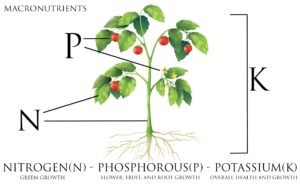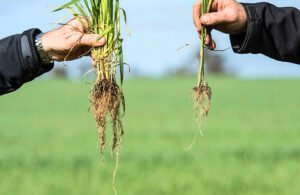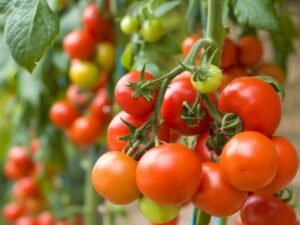Application of Fertilizers In Vegetables
Balanced diet is the main and essential component of our life. Vegetables are of utmost importance in our life. They not only improve our health but also provide the ability to fight against many types of diseases. That is why vegetables are most beneficial for our health. Along with this, some vegetables are powerful as well as have the properties of curing many diseases, otherwise we can also fall ill due to their deficiency.
Vegetables that hold an important place in our lives are grown by farmers in the fields. Whenever we sow vegetables in the fields, before sowing them, the fields are well ploughed and various types of organic, chemical fertilizers are applied in the fields so that the yield is higher.
Read More: Role of NPK for the Plant

But when the crops are threshed after harvesting, it is seen that even after using all the nutrients, they do not get the same production as the farmer expects to win. At the same time, it is also seen that when the next crop is sown, the crop is very weak from the beginning and later it is found that the fertilizer capacity of the soil of the field also decreases, which later provides less production. |
Fertilizers, whether organic or chemical, are used to supply nutrients to the plants. When they need them. Fertilizer should be used based on soil test results and plant needs. Nutrient needs vary between plant families and species. For example leafy green vegetables require more Nitrogen than beans and peas. Some similar fertilizers can be used in this article on the basis of their usefulness in vegetables.
Read More: Importance of Micro Nutrients for Crop Productions
Cabbage – Category Vegetables:
As we all know, there are three types of Cabbage, Cauliflower, Cauliflower and Gum Cauliflower. All the vegetables of Cabbage category are very healthy. Cauliflower contains less protein than pulses but more protein than all other vegetables. The fertilizer and fertilizer requirements of all three types of Cabbage are different. We should mix cow dung, compost and other organic fertilizers in the field at the time of final ploughing.
Well decomposed poultry Manure can be applied a few days after planting. It helps in retaining the moisture in the soil. Due to this, there is no loss of accumulated moisture in the soil and less irrigation works. If the full amount of fertilizer containing phosphorus and potash and half the amount of Nitrogen is mixed together, 10-12 cm should be planted next to the line on which the plant is to be planted. If given at a depth of 4-6 cm at a distance of 4-6 cm, then the yield is good.
The remaining quantity of Nitrogen should be mixed well with a shovel in the soil after about 40 days after planting all the three types of Cabbage plants. By dividing the total amount of Nitrogen in cauliflower in three equal amounts, a good crop is obtained.
Read More: Soil Testing Importance & Usefulness
After 20 days of planting in the first quantity, it should be kept near the plant with a scabbard and mixed in the soil. The second dose should be given 40 days after transplanting and the third dose should be given a few days (5-10) before flowering. In this, irrigation should be done according to the need for full utilization of fertilizers by the plants. If water is given by drip irrigation, then more efficiency in use and better yield can be found.
Spraying of Nitrogen-rich fertilizer (urea) is especially beneficial for Cabbage. In case of deficiency of micronutrients, making a solution of micronutrients in proper concentration should be sprayed on the leaves. Land based experiments prove to be particularly beneficial.

Tuber Vegetables:
Radish, carrot and turnip are prominent among the vegetable vegetables, these crops are cultivated in India. It is often grown in the garden or kitchengarden of the house.
Radish, Carrot: These vegetables can be major sources of nutrients. These crops are generally grown in light textured loamy or loamy soils which are less fertile than other soils. Therefore, in order to get good yield, it becomes necessary to combine and balanced use of Manures and fertilizers. Full amount of Phosphorus and Potash along with remaining half dose of Nitrogen should be applied with second irrigation.
Read More: Importance of Potash For Crop Production
Turnip: Turnip is the foremost and rich yielding winter vegetable among tuber vegetables. Like radish, turnip is cultivated more informed soils. Therefore, the use of Manure and fertilizers becomes absolutely necessary for good yield.
Manure of cow dung or compost should be mixed in the field at the time of first ploughing. At the time of last ploughing, full amount of phosphorus and potassium and half of Nitrogen should be added to the soil. When the roots of the plants emerge properly, then the remaining amount of Nitrogen should be used by topdressing. Due to the use of fertilizer in standing crop, the growth of plants is relatively more and faster.

Arbi: Arbi holds an important place in root crops as well as it is also a good source of nutrients. For its cultivation, 20-25 days before the preparation of the first field, rotted Manure of cow dung or compost at the rate of 20-25 tonnes per hectare should be mixed in the field.
Read More: Chemical Fertilizer and its impact on Agriculture
Before sowing, put half the amount of Nitrogen and full amount of phosphorus and potash in the field and soil well should be mixed in. The remaining amount of Nitrogen should be used twice. , Half of the quantity should be used after planting and the remaining half should be used in the last week of June or first week of July while soiling.
Sweet potato: At the rate of 200 quintal per hectare while preparing the field, Manure should be mixed well in the soil. Then Nitrogen, phosphorus and potash should be applied with the last ploughing.
Brinjal: Brinjal is an important crop of our country and is grown in almost all parts of the country. If the use of fertilizer for a good crop of Brinjal, determining the quantity according to the fertility and variety of the soil will prove to be very beneficial.
At the time of field preparation, decomposed cow dung at the rate of 20-25 tonnes per hectare should be used. Half quantity of Nitrogen and full quantity of phosphorus and potash should be mixed in the field before transplanting. The remaining amount of Nitrogen should be used once or twice as topdressing in the standing crop.

Manure and fertilizer should be used separately in the standing crop of Brinjal. 20-25 days before transplanting, 150-200 quintals of decomposed cow dung should be mixed well in the soil while preparing the field. At the time of last ploughing, half quantity of Nitrogen and full quantity of phosphorus and potash should be applied in the soil at a depth of 8-10 cm with the help of ploughed. If this is not possible, then these fertilizers should be well tilled and mixed in the soil.
Read More: Farming of exotic vegetables
The remaining half of the Nitrogen should be applied 40 days after transplanting in the middle of the row of standing crop and applied well to the soil. Using fertilizer in this way can give relatively good results.




